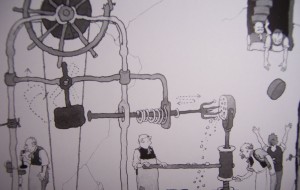 Later in his career, the famous artist William Heath-Robinson (1872-1944) created works of great ingenuity that showed complex inventions that were created to solve real everyday problems. The genius of his work was that his held-together-with-string contraptions looked comically plausible. This genre of harmless mad-inventorism has endured, for example as the eccentric Wallace and Grommet characters.
Later in his career, the famous artist William Heath-Robinson (1872-1944) created works of great ingenuity that showed complex inventions that were created to solve real everyday problems. The genius of his work was that his held-together-with-string contraptions looked comically plausible. This genre of harmless mad-inventorism has endured, for example as the eccentric Wallace and Grommet characters.
The problem arises when this seat-of-the-pants incremental invent-patch-and-fix approach is applied to real systems – in particular a healthcare system. We end up with the same result – a Heath-Robinson contraption that is held together with Red Tape.
The complex bureaucracy both holds the system together and clogs up the working – and everyone knows it. It is not harmless though – it is expensive, slow and lethal. How then do we remove the Red Tape to allow the machine to work more quickly, more safely and more affordably – without the whole contraption falling apart?
A good first step would be to stop adding yet more Red Tape. A sensible next step would be to learn how to make the Red Tap redundant before removing it. However, if we knew how to do that already we would not have let the Red Tapeworms infest our healthcare system in the first place! This uncomfortable conclusion raises some questions …
What insight, knowledge and skill are we missing?
Where do we need to look to find the skills we lack?
Who knows how to safely eliminate the Red Tapeworms?
Can they teach the rest of us?
How long will it take us to learn and apply the knowledge?
Why might we justify continuing as we are?
Why might we want to maintain the status quo?
Why might we ignore the symptoms and not seek advice?
What are we scared of? Having to accept some humility?
That doesn’t sound like a large price to pay for improvement!
